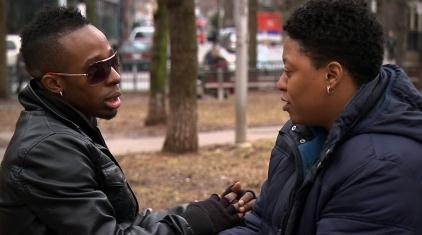Paul-Émile d’Entremont calls himself a “child of Trudeau.” He’s been nourished on a diet of multiculturalism. For this reason the filmmaker and journalist is a little sad about the current government, which, he says, is throwing away Canada’s reputation as a place where anyone can make a fresh start as an immigrant – especially those who flee their home countries out of fear.
D’Entremont is the man behind Last Chance, a National Film Board documentary that follows the lives of five gay, lesbian and transgender individuals who come to Canada in search of new lives, free from persecution.
There is Trudi, a lesbian from Jamaica who was “correctively” raped at gunpoint. Zaki, who was thrown into an Egyptian jail. Carlos, who left his son behind in Colombia. Jennifer, a transgender woman who was institutionalized by her own family. And finally there is Alvaro, a gay man who sought refuge in Canada in a high-profile case covered extensively by Xtra.
D’Entremont says that while he has worked on documentaries in the past, creating Last Chance was the first time he took an advocacy approach to filmmaking. “I think gays in Canada, we’ve got work to do, but we have acquired a lot of rights. And I’ve noticed in the gay press that there are a lot of people looking outward now as to what is going on in the rest of the world. And I was doing the same thing,” he says.
Six years ago, d’Entremont met a group of activists in Montreal through HELEM, a Lebanon-based gay rights advocacy organization. He was inspired by the stories he heard of people who risked and lost so much to come to Canada. A few years later, he was shooting on the streets of Beirut with Jennifer, a young transgender woman who was looking to come to Canada.
But in the process of filming, d’Entremont was hedging his bets, documenting individuals who were waiting on visas. “The fascinating thing about documentaries is that it’s real life,” he says. “I didn’t know what was going to happen. When I went to Lebanon, I didn’t even know that Jennifer would get her visa. If she didn’t, I had no story.”
He says it was a risk worth taking. “This films starts in the country of origin, before the flight ‘home,’ before fleeing persecution,” he says. “To document that persecution, that was very difficult to do, because you had to find someone in their country who not only wants to come to Canada, but also who has the means of coming and had a good chance of getting a visa.”
Through the film d’Entremont underscores a problem many would-be queer refugees face: because Canada has a strong record of allowing refugees into the country, it is difficult to obtain visas that allow individuals to come here. “When you apply, they want to know that you have a stable income in your home country and that you’re not going to Canada for economic reasons,” d’Entremont says. “It also helps if you have family connections, such as a wife, kid, which frequently gays and lesbians may not have.”
But the problems don’t end there. Once they arrive in Canada, applicants looking for refugee status have to prove that they are gay, lesbian, bisexual or transgender.
Although Canada was one of the first countries to view persecution based on sexual orientation as a reason to grant refugee status, there are still cracks in the system. D’Entremont says lawyers often get their clients to supply letters, emails, perhaps even love letters to present at their hearings. “They can even get someone to testify and say, ‘Yes, I have slept with this person,’ ‘Yes, this is my partner, I am in love with them.’ Those are ways that you establish sexual orientation.”
But proving sexual orientation is not easy for people who have spent their lives trying to hide it. Refugee adjudicators have also been accused of relying on stereotypes, and d’Entremont mentions stories of people who were rejected, told that “this man doesn’t look gay, or this man has big hands and a masculine demeanour, stuff like that.”
Looking at Canada’s problems on this front, d’Entremont sees a country and a system that is failing the people who risk everything to access it. He wants to see changes to that system, as well as changes in how the people who use it are perceived. “When I found these people I was inspired by them, by the fact that they were willing to leave everything,” he says. “I mean, a lot of people say, ‘Of course they want to come to Canada,’ but let me tell you it’s not that easy to give up everything. Everything. And to start again. I am inspired by how grateful these people are to be in Canada and how hard they worked to integrate. I hope my film will offer a different point of view than what is the prevailing attitude towards immigrants and refugees that is very widespread in Canada, that they are just slackers taking advantage of the system.”


 Why you can trust Xtra
Why you can trust Xtra


